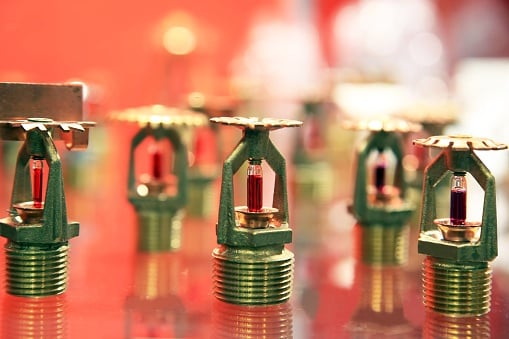
A Quick History of Fire Sprinkler Systems
The modern fire sprinkler system, as we know it today, had its start in 1812. Architect William Congreve installed the first one in the Theatre Royal, Drury Lane in London. It consisted of a series of pierced pipes, which led to a large container of water that was released in the event of a fire. In the 1870’s, Philip Pratt invented the first automatic sprinkler system. The automatic fire sprinkler was then improved by Henry Parmalee and later perfected by Frederick Grinnell in the 1890’s.
While originally used to protect commercial buildings, fire sprinkler systems are now found in almost every building. They have even started to be installed most recently in residential homes. Today, buildings in the US and Canada are required by local code to have properly working fire sprinkler systems installed in them.
The Use and Operation of a Fire Sprinkler
Surprisingly, fire sprinkler systems were not designed to put out fires, but to contain them. When a fire occurs, the heat from the flames increases causing a heat-sensitive glass bulb or metal link in the fire sprinkler head above the fire to break. Once the bulb or link is broken, water then flows from the sprinkler head suppressing the fire until the authorities arrive to extinguish it. In many instances though, the sprinkler system is able to extinguish the fire completely.
Another misconception about fire sprinkler systems is that when a fire happens, all the sprinkler heads are activated throughout the building. While you may have seen this occur in movies, this is not how most fire sprinkler systems operate. In a real fire, the heat from the fire rises, which activates the sprinkler heads above the fire.
In most modern installations, you’ll notice that the sprinkler heads use a heat-sensitive glass bulb rather than a metal link. The glass bulbs contain a liquid that has a precise boiling point. The bulb breaks from the liquid inside it boiling and bursting the glass bulb. Since the ambient temperature can vary depending on the space, there are different bulbs with different boiling points. In a standard office building, the temperature has to reach 155 degrees Fahrenheit for the bulb to break and the sprinkler head to activate.
Changes to Fire Sprinkler Systems
A fire sprinkler system is a pretty simple system that has changed very little from its beginnings over a century ago. Still, some advancements have been made to improve its effectiveness over the years. As stated earlier, modern sprinkler heads use glass bulbs instead of metal or solder links. The bulbs themselves have variances now. For instance, in office buildings and schools, you will typically find quick response sprinkler heads rather than the standard response sprinkler heads.
The newer quick response sprinkler head uses a smaller glass bulb which has a slightly faster response time than the standard response sprinkler. The quick response sprinkler also discharges the water higher up the walls to keep the fire from climbing and to reduce the ceiling temperatures.
Fire pumps are another recent addition over the past half-century, which deliver pressurized water to high rises. Also, the recent integration of sprinkler systems with fire alarm panels has resulted in quicker responses from authorities. The overall infrastructure of the public water system has also helped improve fire sprinkler systems. Cities and towns now have much more reliable water pressure than in decades past, allowing sprinkler systems to operate effectively.
The Benefits of Sprinklers
According to the National Fire Protection Association (NFPA), fire sprinklers have been found to greatly reduce damage from fires in restaurants, schools, health care facilities, offices, and stores. Damages from fires cost on average $53,000 in restaurants without sprinkler systems, compared to $13,000 in restaurants with sprinkler systems.
While fire sprinklers have been proven to reduce property damages, they are still rare in certain buildings. From 2007-2011, they were found in only 36% of schools that experienced fires and in only 24% of stores and offices that experienced fires. They were only present in 6% of homes that had fires, which is where most fire deaths occur. The recent push for fire sprinklers in homes has been led by the NFPA’s Home Fire Sprinkler Initiative. According to the NFPA, the fire death rate per 1,000 reported home structure fires was lower by 82% in homes with fire sprinklers installed.
While fire sprinklers have been around for over a century and have proven themselves time and time again in saving property and lives, they still have more potential as their use is expanded across all types of structures, from commercial to residential.
To learn more about fire sprinkler systems, including the inspection, testing, and maintenance of them, contact a Koorsen Fire & Security associate today.


